Eleva, Wisconsin, was supposed to be named New Chicago.
But workers painted the letters ELEVA on a local grain elevator and had to stop there when winter fell.
Travelers assumed that was the name of the village, and now it is.
Eleva, Wisconsin, was supposed to be named New Chicago.
But workers painted the letters ELEVA on a local grain elevator and had to stop there when winter fell.
Travelers assumed that was the name of the village, and now it is.
MIT mails its acceptance letters on 3/14 — “Pi Day.”
A weird story clings to the ruins of Minster Lovel Manor House, Oxfordshire, the ancient seat of the Lords Lovel. After the battle of Stoke, Francis, the last Viscount, who had sided with the cause of Simnel against King Henry VII., fled back to his house in disguise, but from the night of his return was never seen or heard of again, and for nearly two centuries his disappearance remained a mystery. In the meantime the manor house had been dismantled and the remains tenanted by a farmer; but a strange discovery was made in the year 1708. A concealed vault was found, and in it, seated before a table, with a prayer-book lying open upon it, was the entire skeleton of a man. In the secret chamber were certain barrels and jars which had contained food sufficient to last perhaps some weeks; but the mansion having been seized by the King, soon after the unfortunate Lord Lovel is supposed to have concealed himself, the probability is that, unable to regain his liberty, the neglect or treachery of a servant or tenant brought about this tragic end.
— Allan Fea, Secret Chambers and Hiding-Places, 1908
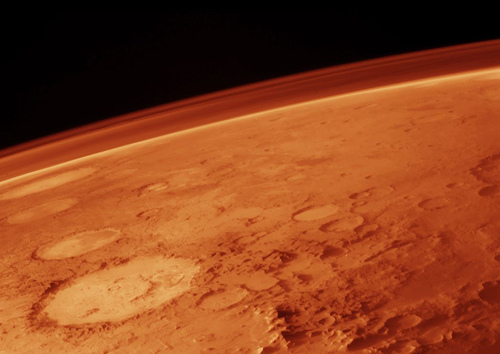
What’s the probability that there are horses on Mars? Let’s be extremely generous and say it’s 1/2. And let’s also say there’s a probability of 1/2 that there are parrots, and aardwolves, and each of 17 other species.
Then the probability that none of these 20 species exists is (1/2)20. And the probability that at least one of them exists is 1 – (1/2)20, or 0.999999046.
Thus it’s nearly certain that there’s life on Mars.
antivitruvian
adj. taking pleasure in destroying architectural monuments
Baseball ain’t always pastoral. In 1920, the Yankees’ Carl Mays pitched a dirty ball against Cleveland shortstop Ray Chapman, who apparently didn’t see it coming. The pitch struck Chapman’s head with such a resounding crack that Mays actually fielded the ball to first base. Chapman died 12 hours later, the only major-league player ever to have been killed in a game.
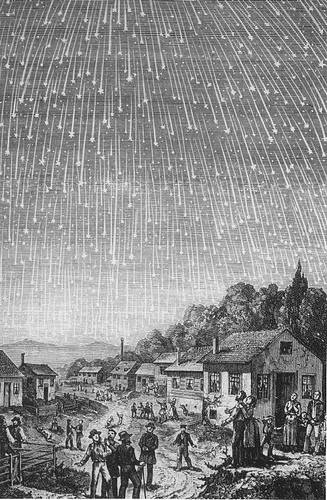
The annual Leonid meteor shower was unusually spectacular in November 1833, raining a hundred thousand meteors per hour over the eastern United States.
“[There were] thousands of luminous bodies shooting across the firmament in every direction,” wrote the Florence, Ala., Gazette. “There was little wind and not a trace of clouds, and the meteors succeeded each other in quick succession.”
That spectacle is remembered in a unique way — it’s the basis of the jazz standard “Stars Fell on Alabama”:
I never planned in my imagination
A situation so heavenly
A fairy land where no one else could enter
And in the center just you and me
We lived our little drama
We kissed in a field of white
And stars fell on Alabama last night.
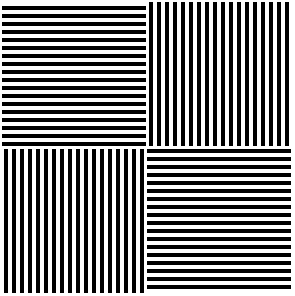
There’s no color in this image, right? Now scroll down and stare at the colored boxes below. There’s no need to focus on any particular spot, just look at the boxes for a few minutes. Then look at the first image again. The horizontal gratings will look greenish and the vertical gratings pink.
That’s not especially impressive, but come back tomorrow and the effect will still obtain. It’s not a simple afterimage. Print out the grid and carry it around with you. Rotate it 45 and 90 degrees and see what happens. If you invest 10 minutes in looking at the colored boxes, the aftereffect can last up to 24 hours.
No one’s sure what’s behind this phenomenon; its discoverer, Celeste McCollough, thinks the induction temporarily modifies the cells in the visual cortex that respond to color and orientation.
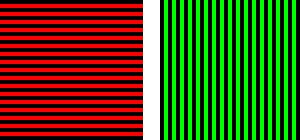
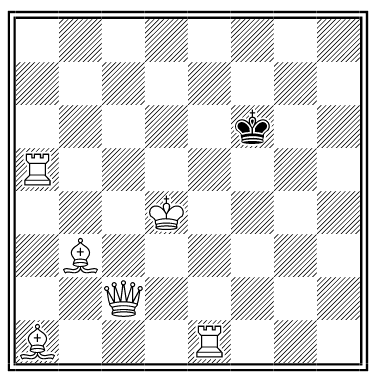
Composed by Tolosa.
Solution: Lift the king into the air.
On July 25, 1956, 14-year-old Linda Morgan was in her cabin on the Andrea Doria when it collided with the Stockholm in the North Atlantic. It was feared she had been killed in the disaster: She did not reach any rescue ship, and the Andrea Doria capsized and sank the next morning.
But then a strange story emerged. Shortly after the collision, a crewman on the Stockholm had heard a young girl calling for her mother from behind a bulwark. “I was on the Andrea Doria,” she told him. “Where am I now?”
Apparently the collision had flung her out of her bed and into the other ship. She suffered only a broken arm.